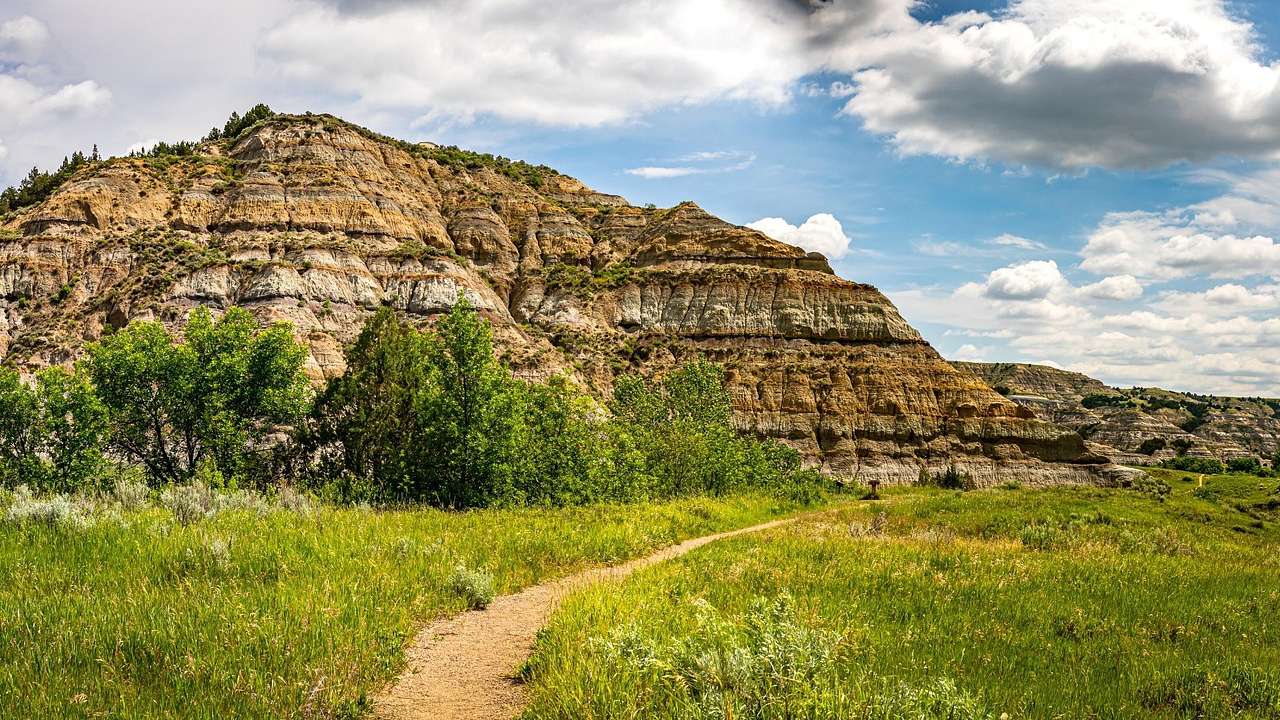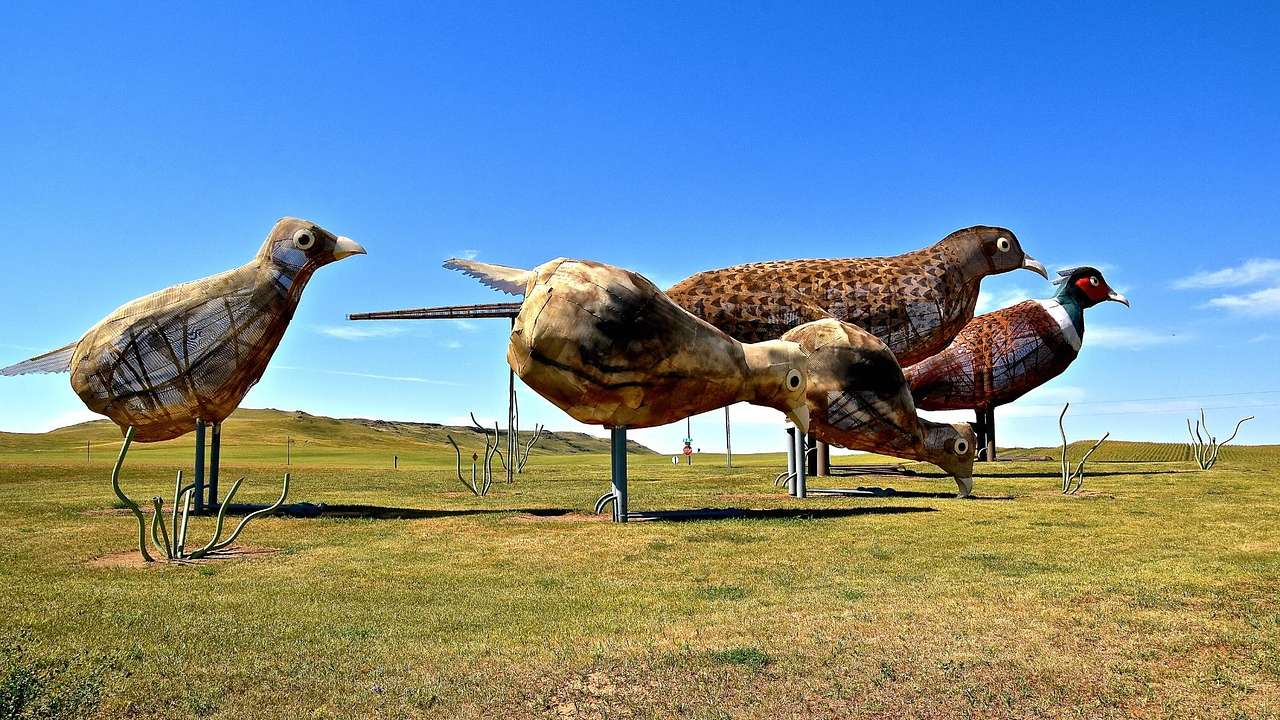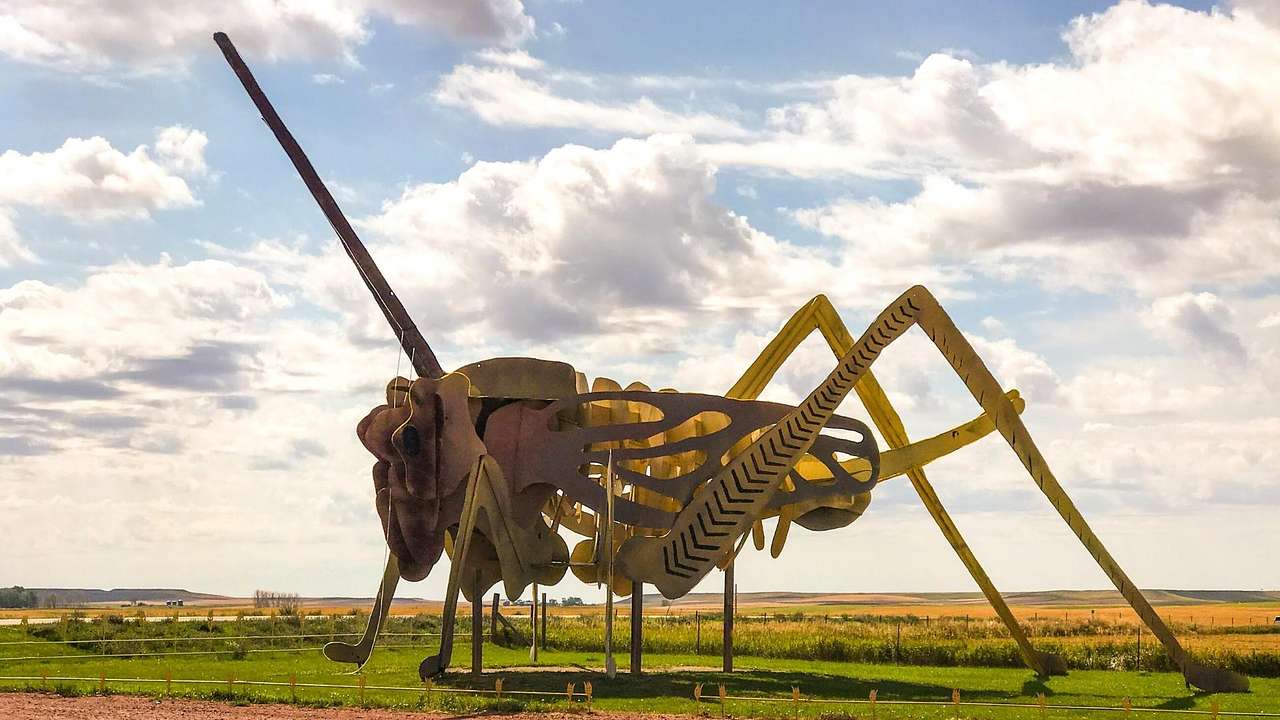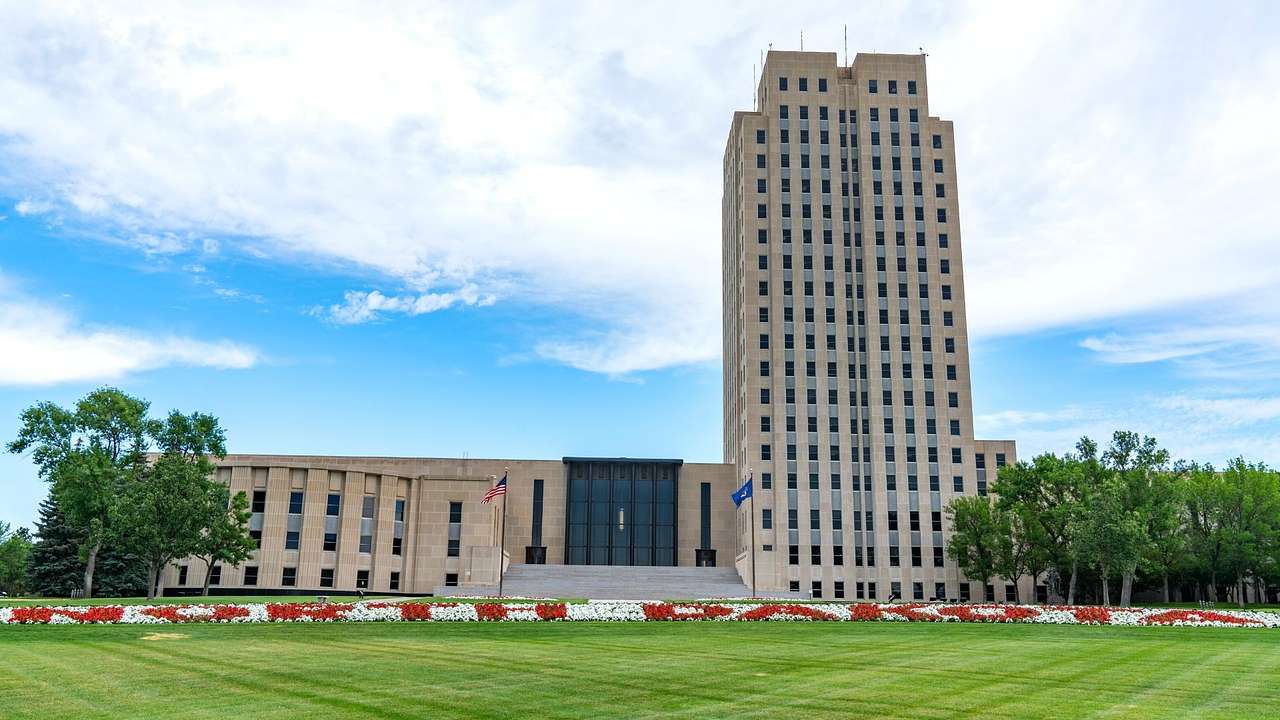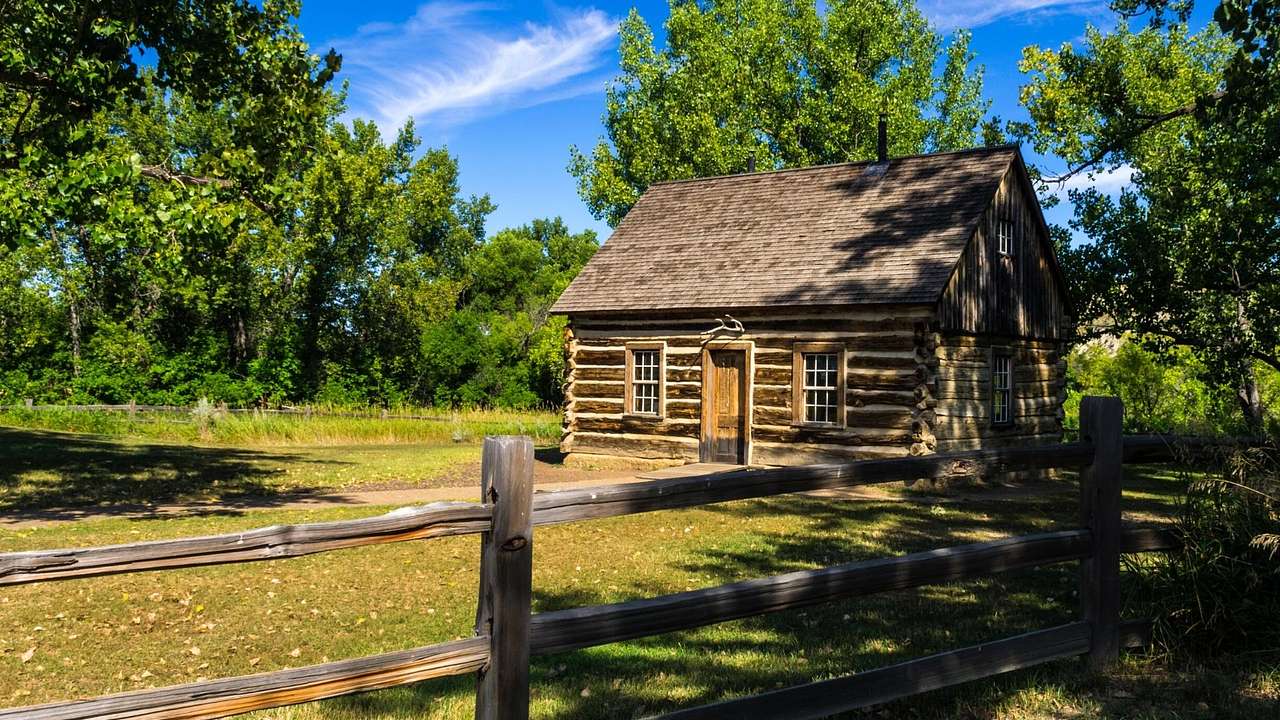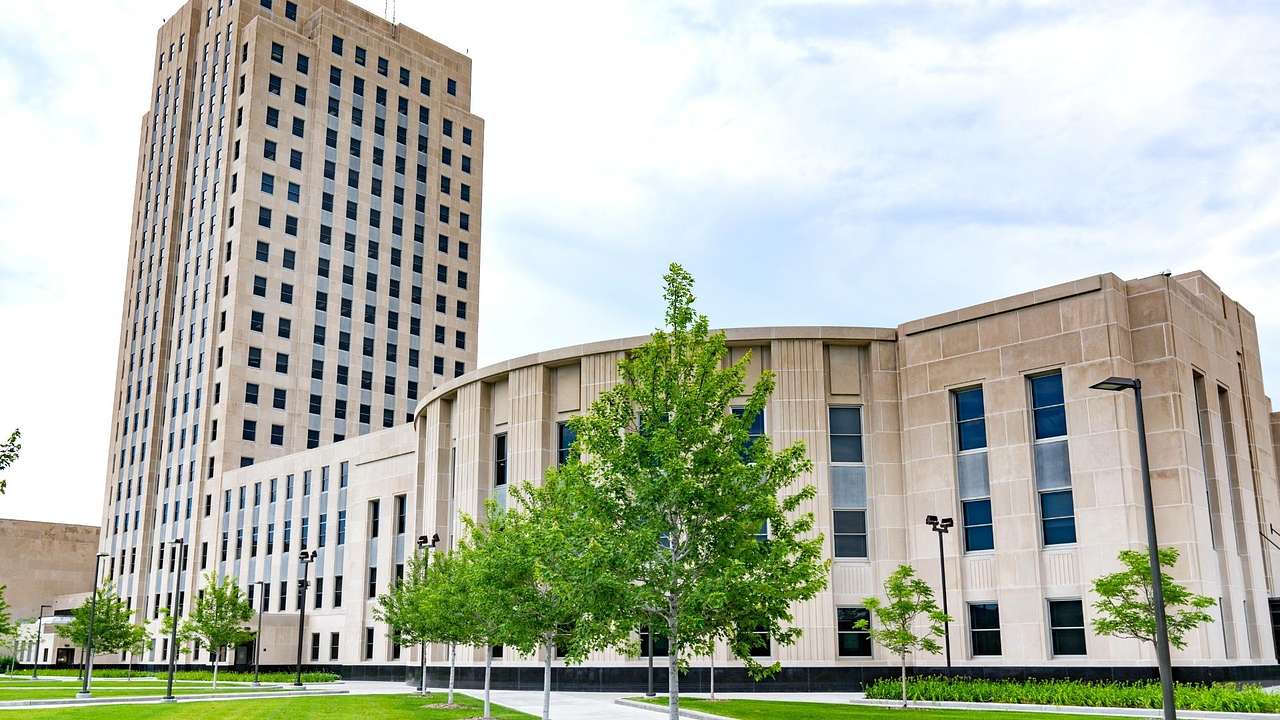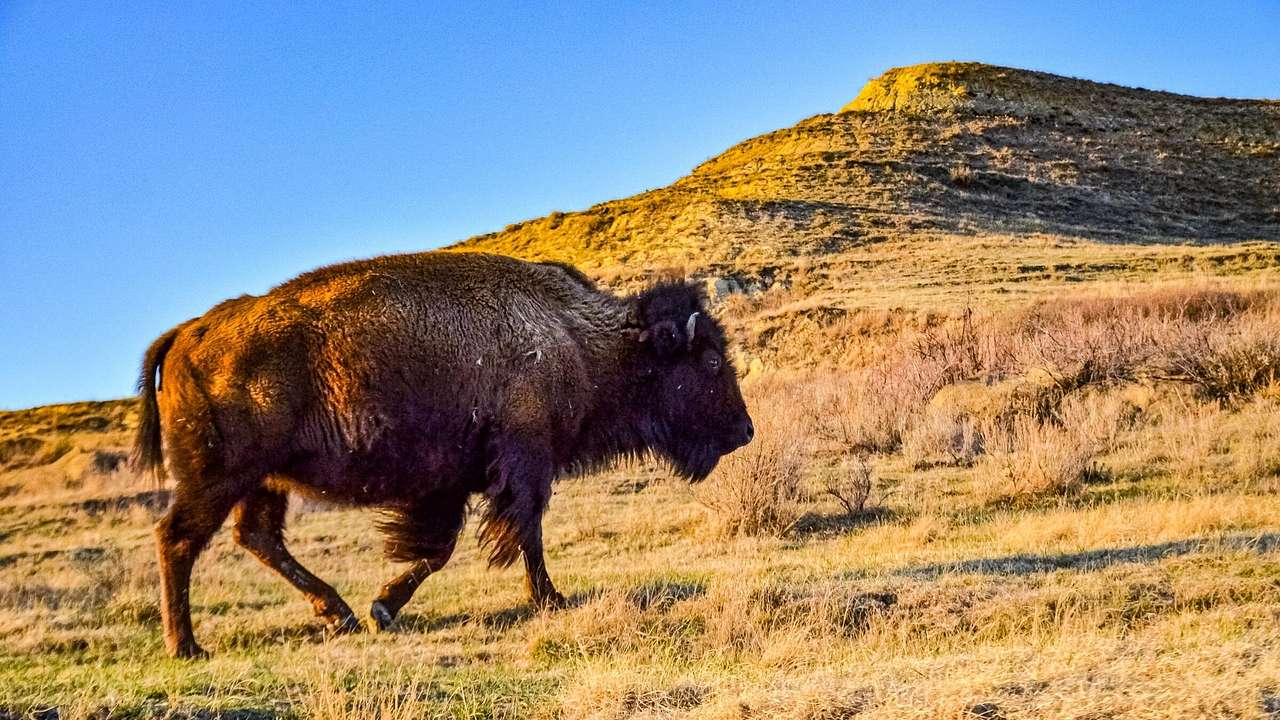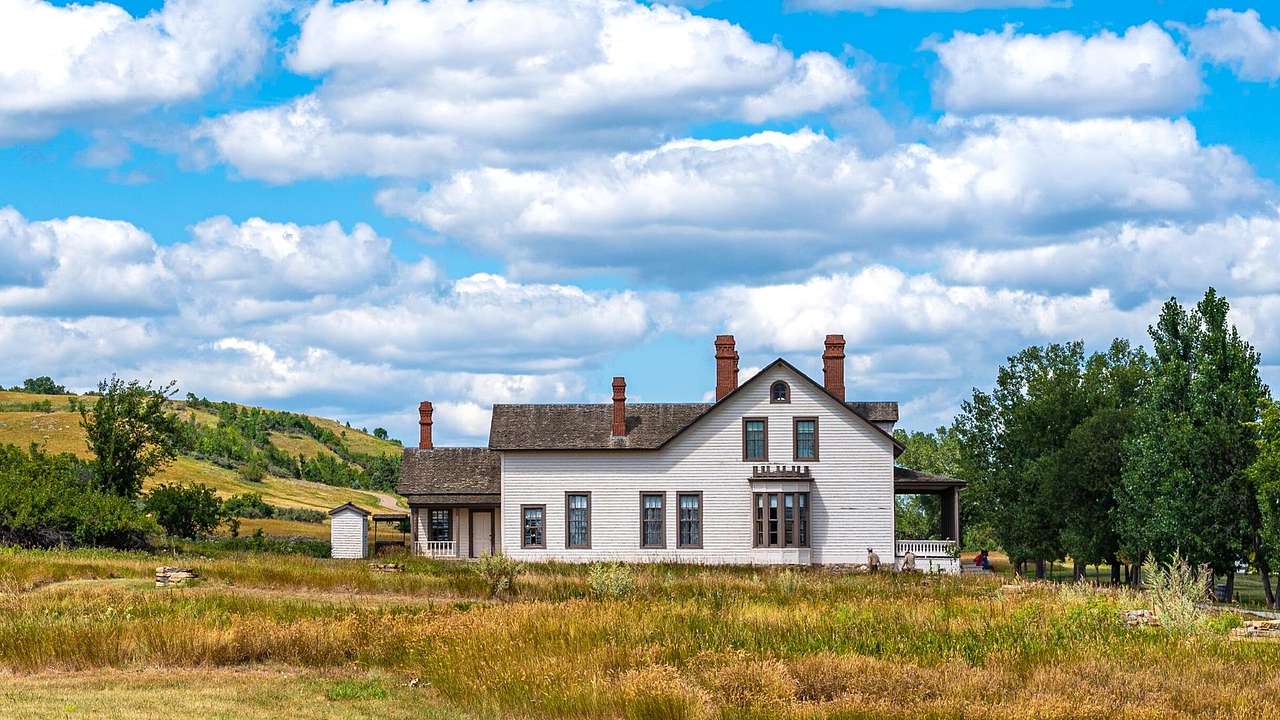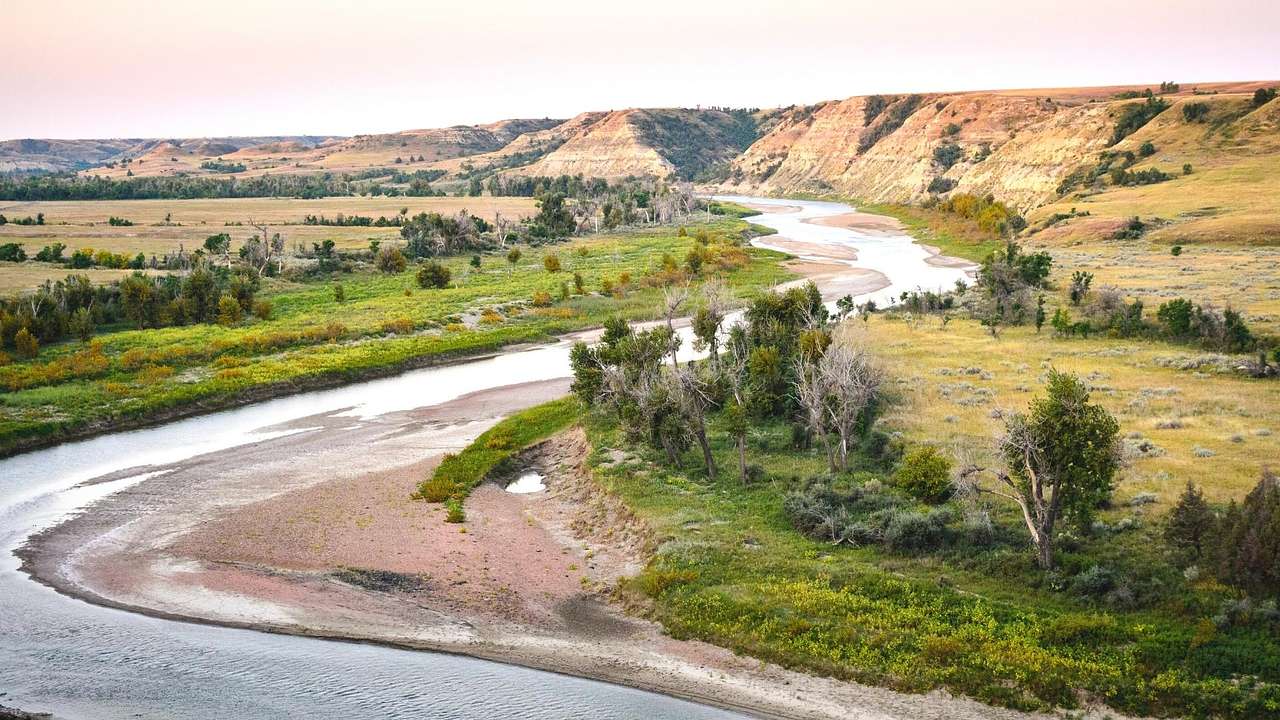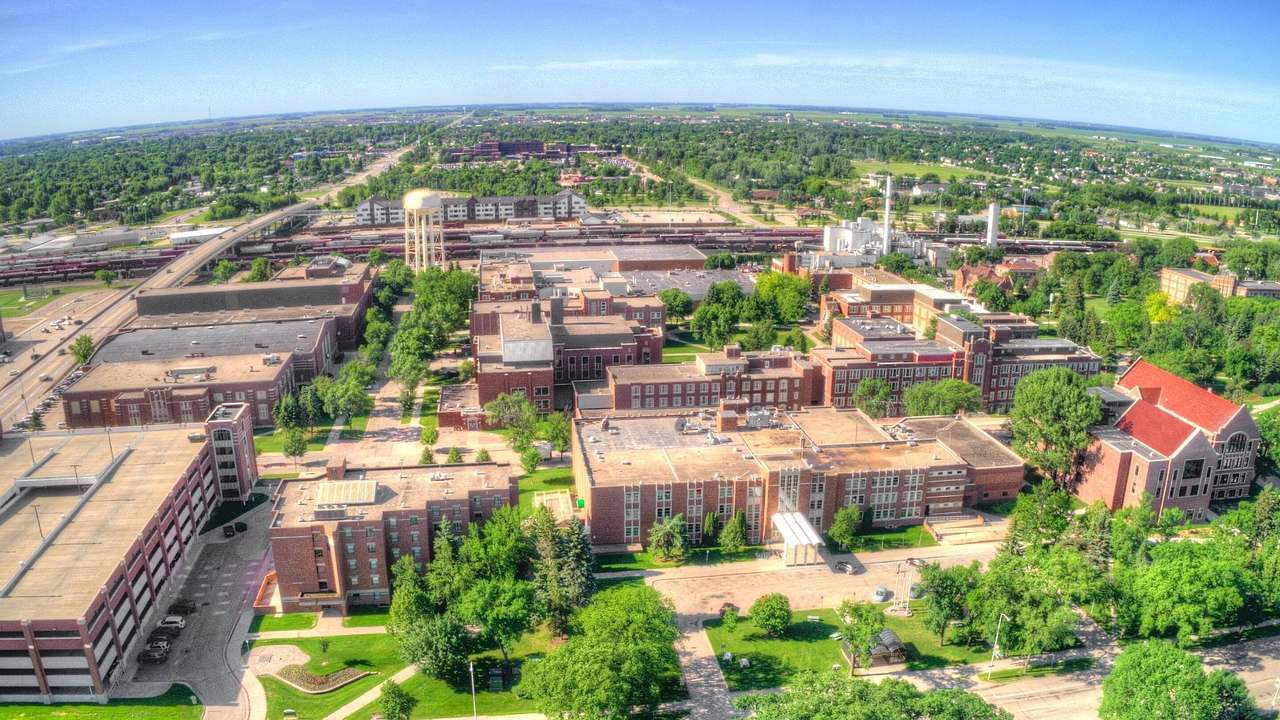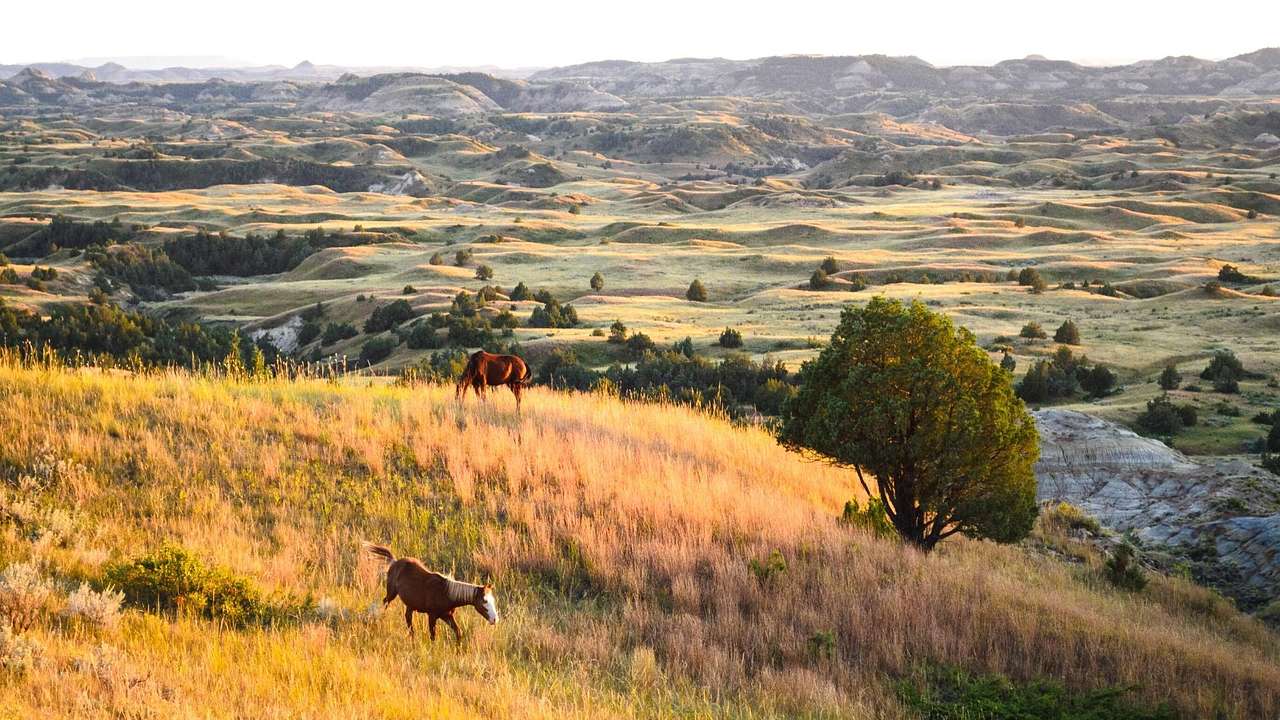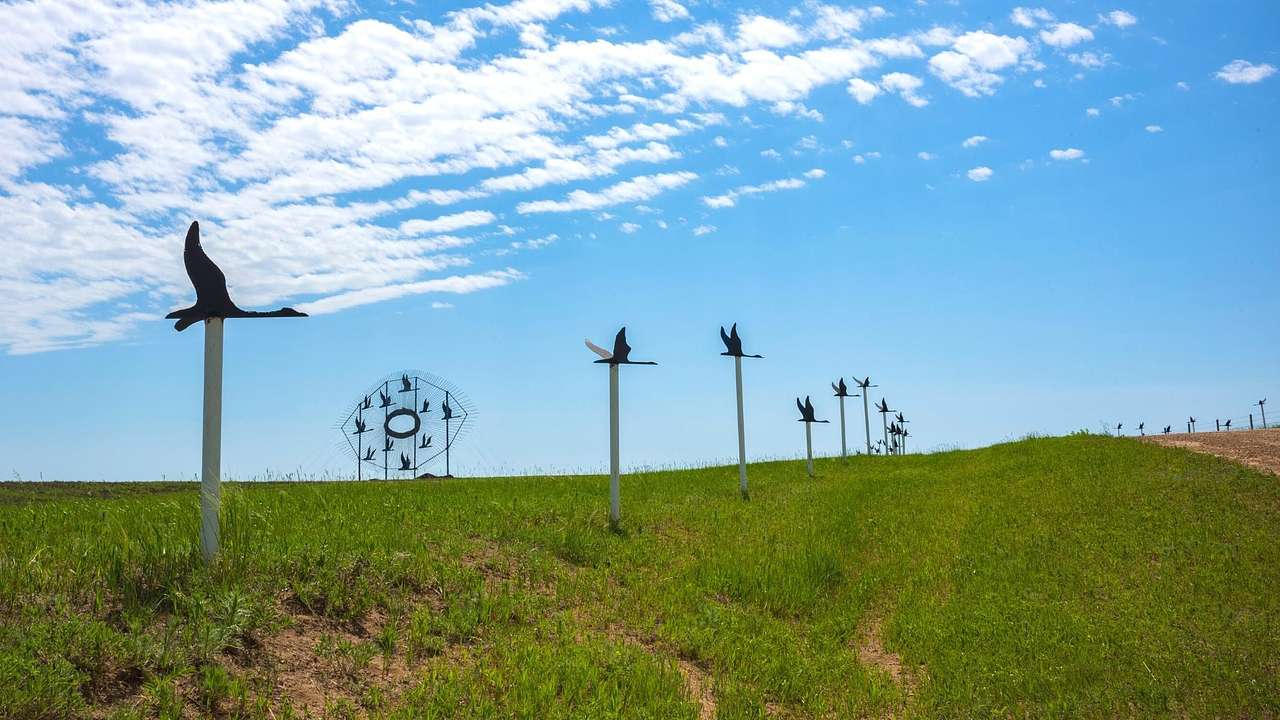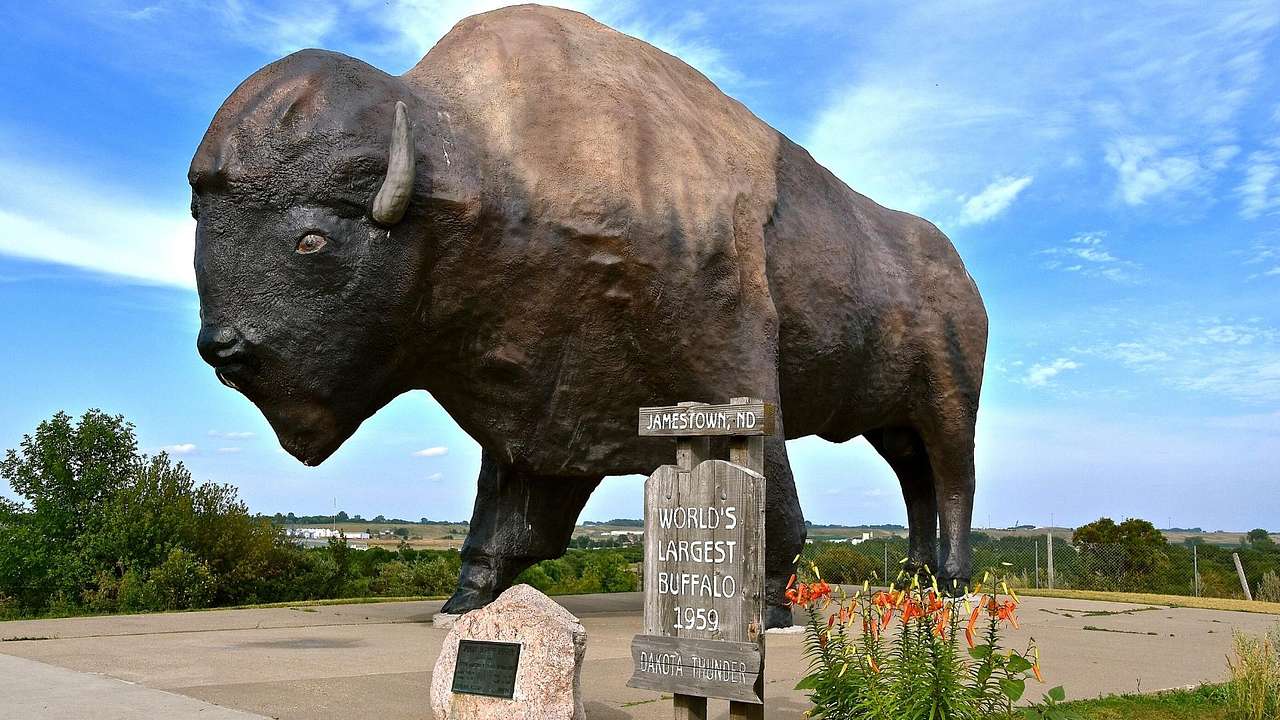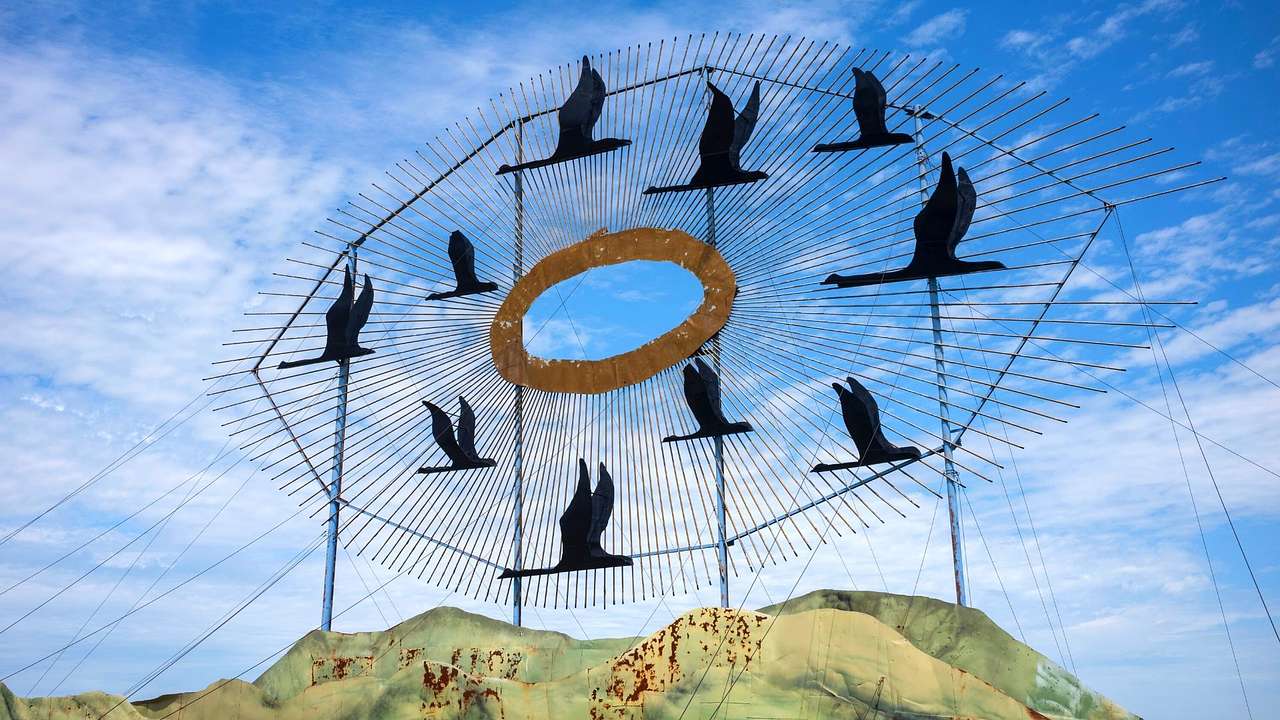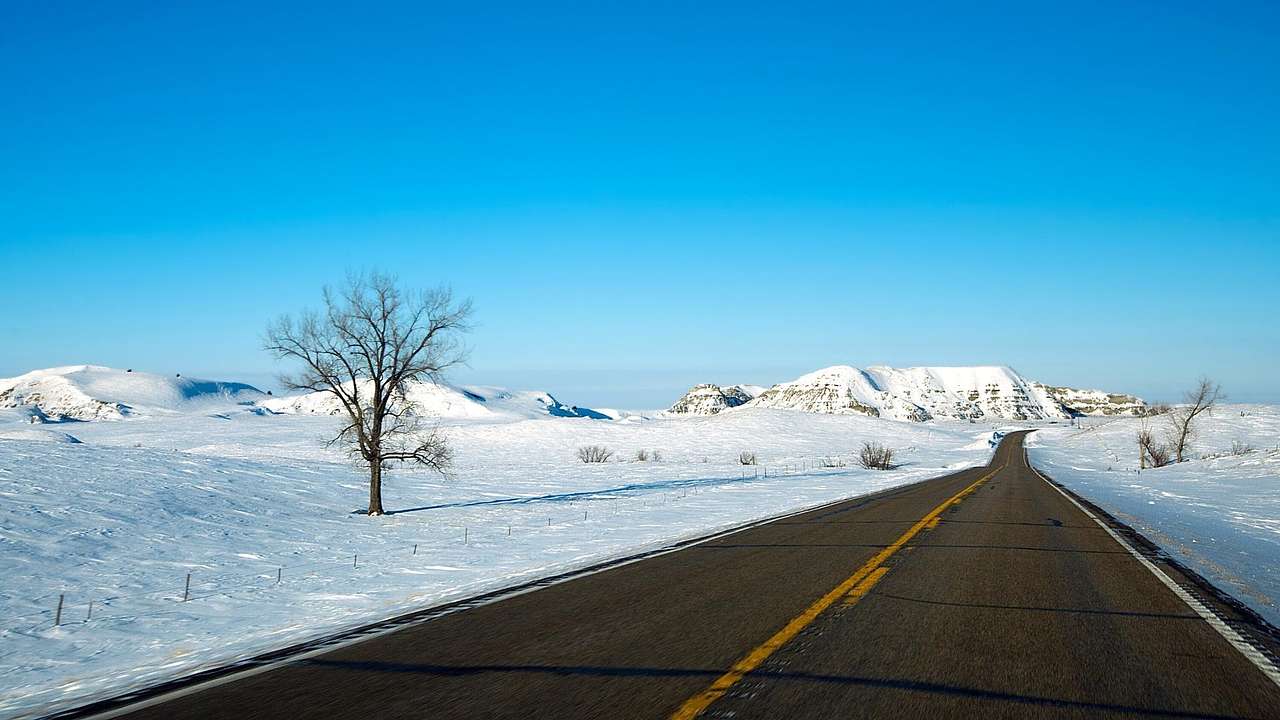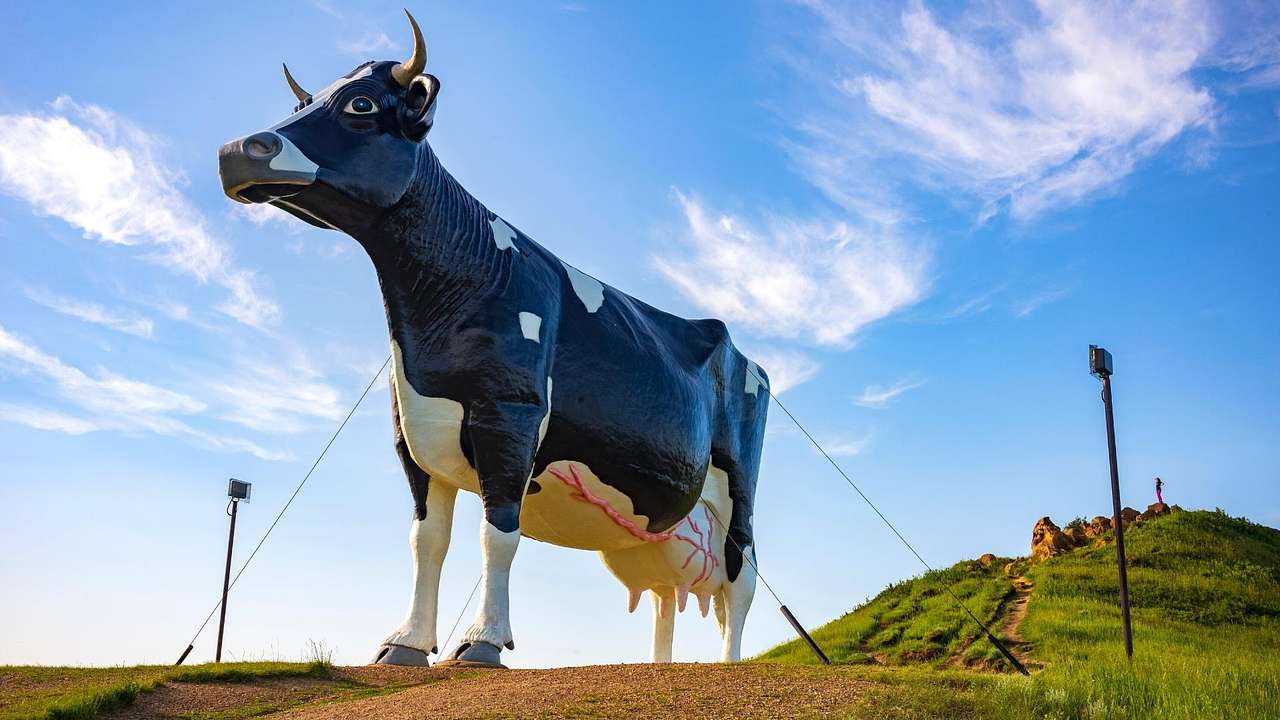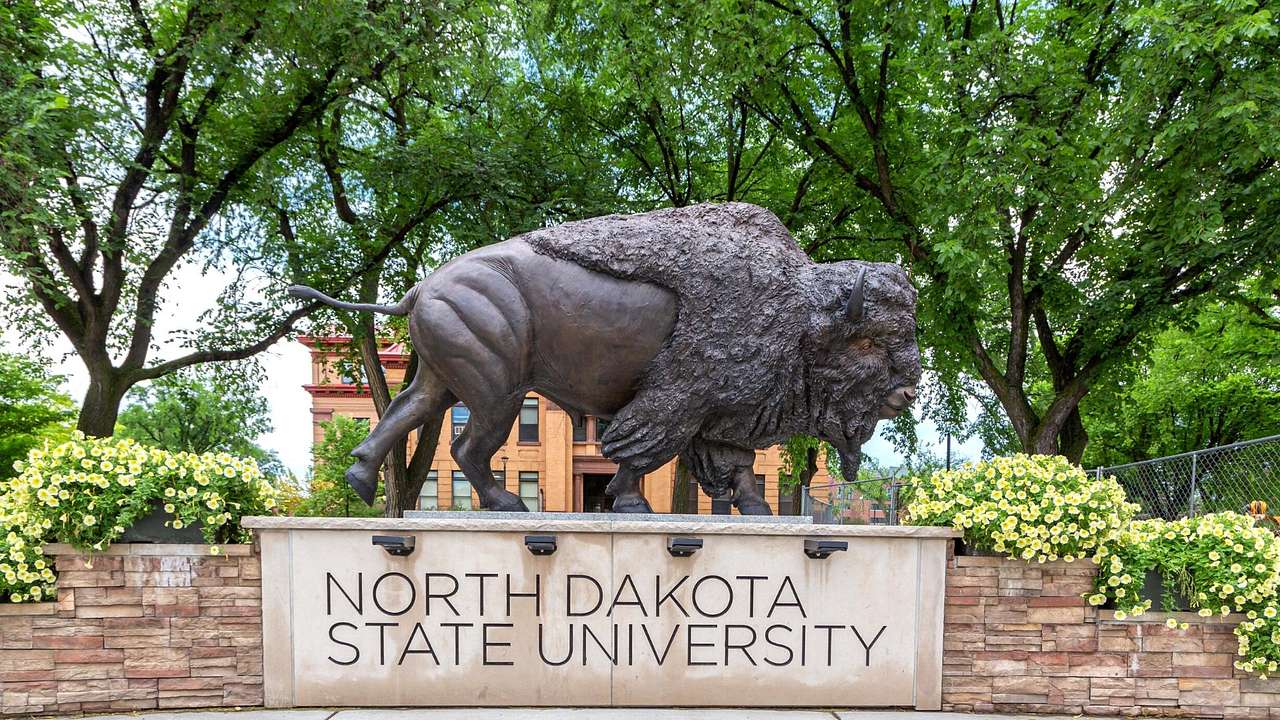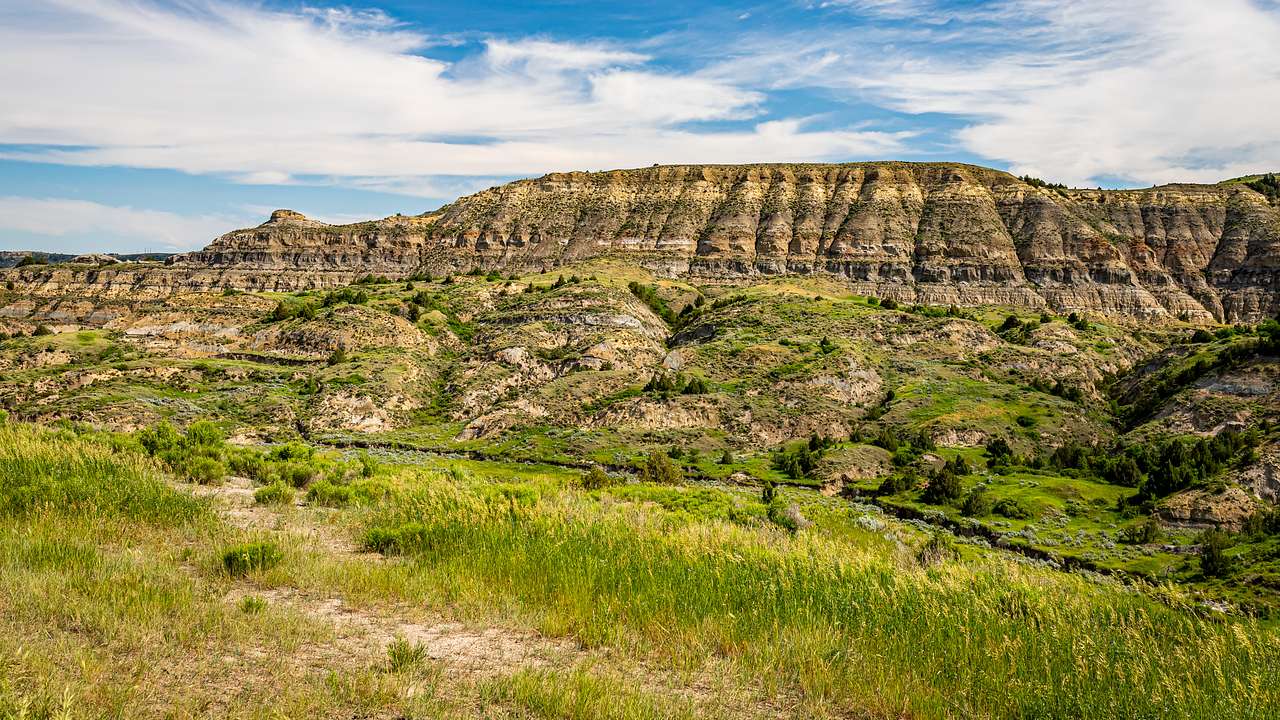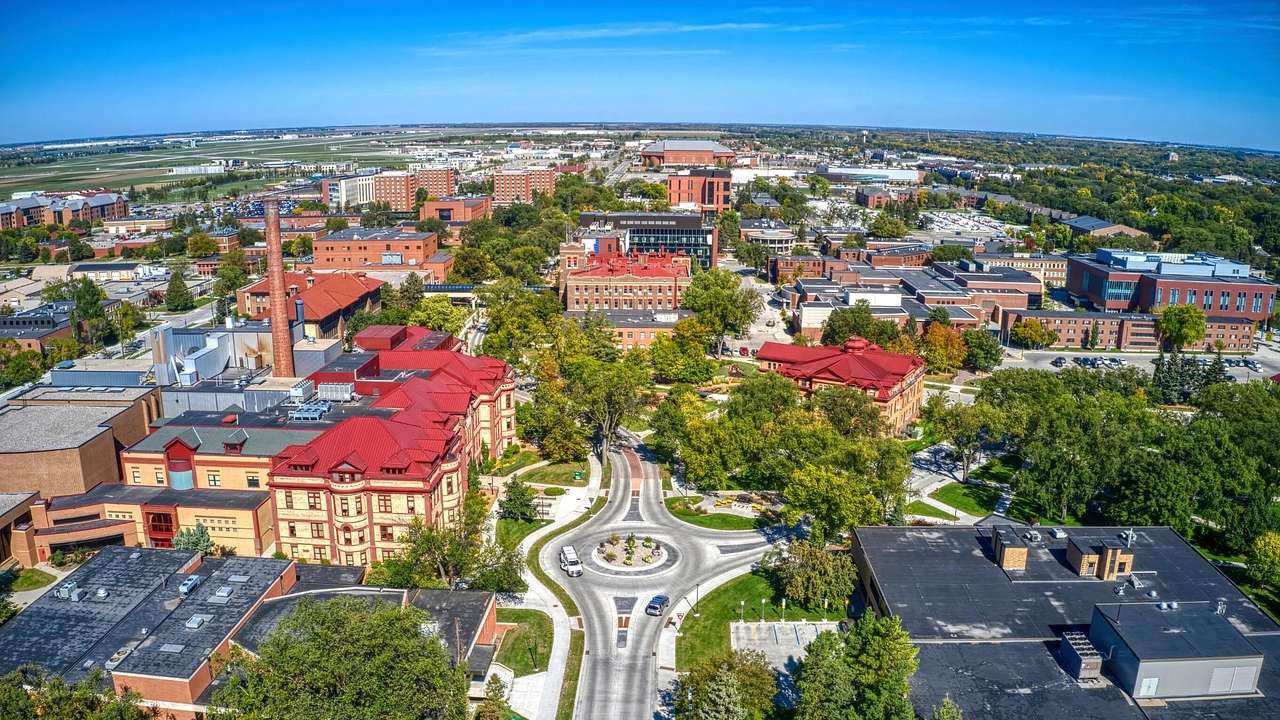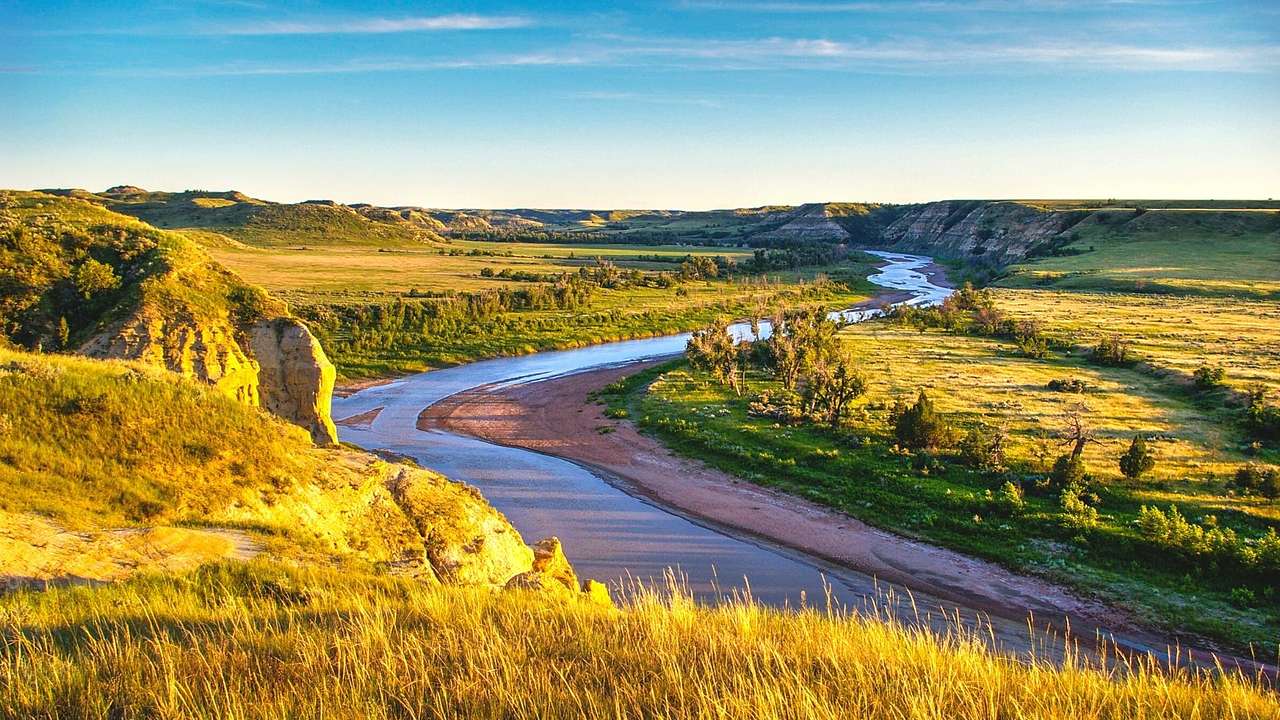50 Interesting & Fun Facts About North Dakota State to Know
Destguides may receive commissions from purchases made through affiliate links in this article.
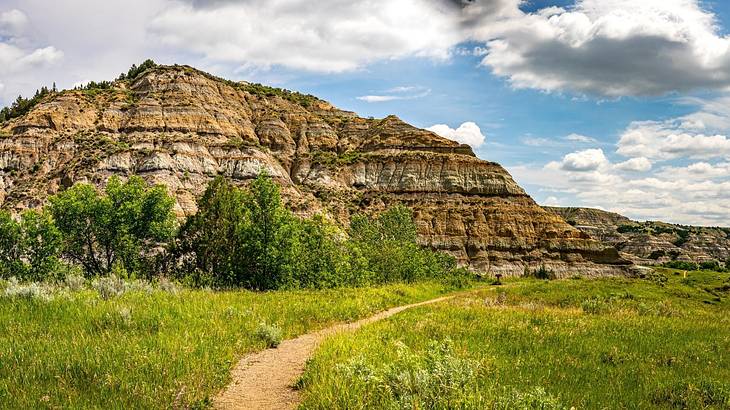
North Dakota is located in the northern part of the United States. Canada borders it to the north, Minnesota to the east, South Dakota to the south, and Montana to the west. But what is North Dakota known for?
The Peace Garden State is known for having a tall state capitol building, which is the tallest building in the state. The state also holds world records for the most snow angels made in one place, the tallest metal sculpture, and the largest pancake feed.
North Dakota is also unique because it has a state drink, which is milk, and the geographical center of North America is here. The state was part of the Dakota Territory until it was split in two, leaving the other half as South Dakota.
Keep reading for more interesting and fun facts about North Dakota State that will fascinate you! These facts include weird, cool, interesting, and scary facts about the state.
50 North Dakota State Facts
-
North Dakota Fun Facts
- The Enchanted Highway is in North Dakota
- The Red River Valley is the lowest land in North Dakota
- One North Dakota State nickname is the "Peace Garden State"
- North Dakota is also called the "Roughrider State"
- The name "Dakota" comes from a Sioux word
- North Dakota is over 66 times larger than Rhode Island
- The North Dakota State Capitol cost two million dollars to build
- President Theodore Roosevelt loved North Dakota
- The International Peace Garden is in North Dakota
- The state capitol is the tallest building in North Dakota
- North Dakota is one of the least-visited states in the US
- There is a lot of wildlife in North Dakota
- North Dakota contains a lot of lignite
- A re-creation of the Custer House is in North Dakota
- The Nonpartisan League political party started in North Dakota
-
Interesting Facts About North Dakota
- North Dakota has the least amount of forest land of any state
- Grand Forks is the third-largest city in North Dakota
- There are 14 North Dakota state parks
- The North Dakota state tree is the American Elm
- The North Dakota state flower is the Wild Prairie Rose
- The North Dakota state bird is the Western Meadowlark
- The North Dakota State flag was first used in the Spanish-American War
- The North Dakota State motto started as the motto of the Dakota Territory
- Theodore Roosevelt National Park is in North Dakota
- The San Haven Sanatorium used to be in North Dakota
- Weird Facts About North Dakota
- Cool Facts About North Dakota
- Scary Facts About North Dakota
- Historical Facts About North Dakota
- Important Facts About North Dakota
North Dakota Facts Video
Check out our highlights video of North Dakota facts.
North Dakota Fun Facts
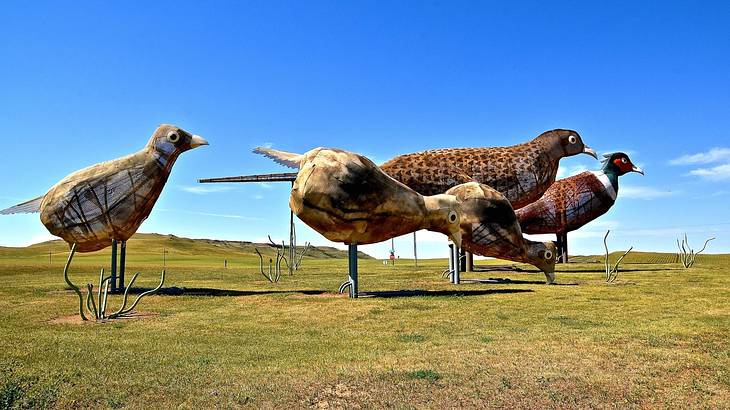
First up are the many fun facts of North Dakota.
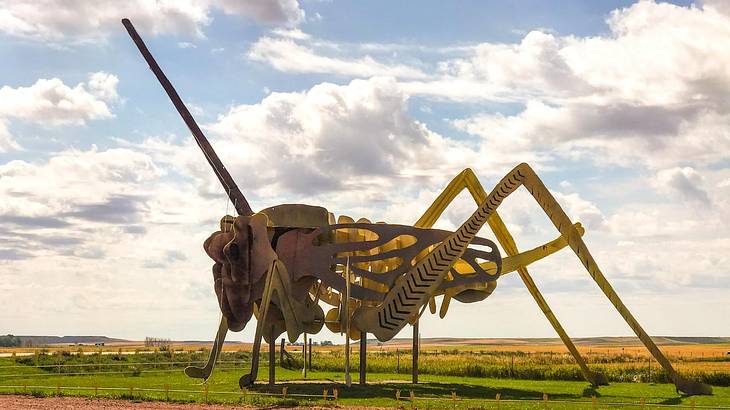
The Enchanted Highway is in North Dakota
The Enchanted Highway is a 32-mile road lined with massive scrap metal sculptures. You will come across seven statues as you drive along the road. Some of the statutes include "Deer Crossing," "Teddy Rides Again," and "Grasshoppers in the Field."
The Red River Valley is the lowest land in North Dakota
It runs along the eastern border of North Dakota, and its lowest point is 750 feet below sea level. The river is the widest in the northern part of the state near Canada, where it is 40 miles wide. It is much narrower in the southern part of the state, where it is only 10 miles wide.
One North Dakota State nickname is the "Peace Garden State"
It is called this because the International Peace Garden is in North Dakota. The name Peace Garden State was added to the state license plates in 1956. People liked the name, so it was made the official North Dakota state nickname.
North Dakota is also called the "Roughrider State"
The name comes from the cavalry that Teddy Roosevelt organized to fight in the Spanish-American War. Many of the people in the cavalry were from North Dakota. There were bills passed in 1971 and 1973 proposing to change the name on license plates to the "Roughrider Country," but they were denied.
The name "Dakota" comes from a Sioux word
One interesting fact about North Dakota is the origin of the name. The word "Dakota" means "friend". There is both a Dakota Tribe and a Sioux Tribe which used the term in their language. Before North Dakota was a state, it was the Dakota Territory, or the friend territory, along with what is now South Dakota.
North Dakota is over 66 times larger than Rhode Island
The land area of North Dakota is 68,994 square miles. Rhode Island is the smallest state, with a land area of only 1,034 square miles. North Dakota is precisely 66.73 times larger than Rhode Island.
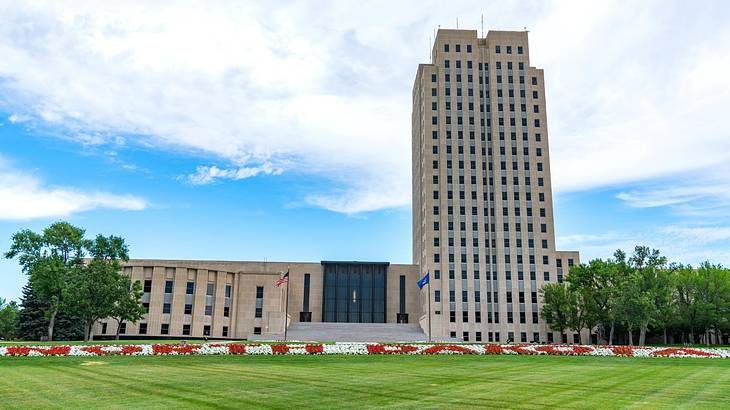
The North Dakota State Capitol cost two million dollars to build
It was completed in 1934, and the workers who built it were only paid $0.30 per hour when construction started. However, they went on strike and got paid $0.50 per hour for the remainder of the project. The building was extended in 1980, which cost $10.5 million to build.
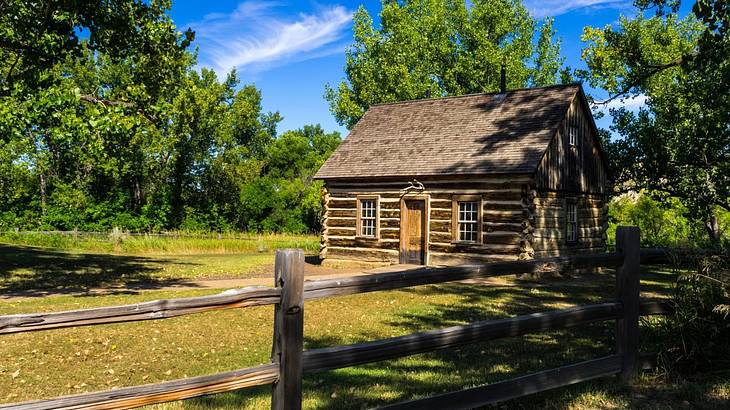
President Theodore Roosevelt loved North Dakota
Although Teddy Roosevelt is from New York, he arrived in North Dakota on September 8th, 1883, and was immediately smitten with the state. He wanted to kill a buffalo when he was there, which he did. But he also invested in ranches, got in bar fights, and lived the life of a true North Dakota cowboy.
The International Peace Garden is in North Dakota
The site lies between North Dakota and Ontario, Canada, and it was created to establish friendship between the people of the two countries. The International Peace Garden broke ground on July 14th, 1932.
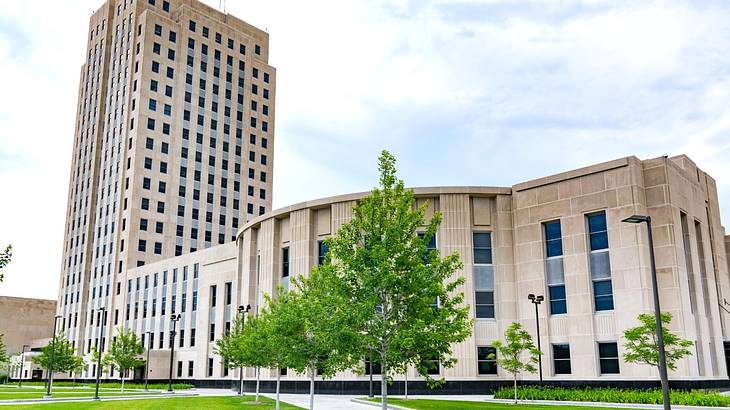
The state capitol is the tallest building in North Dakota
The capitol building is a high-rise building that is 242 feet tall. Since it is the tallest building in the state, it has the nickname "Skyscraper on the Prairie." Despite being a large building, it has been expanded with a judicial wing.
Even still, not all the state government workers fit in the building, and there are other government buildings throughout the capital city. The state capitol grounds are open to the public and have gardens.
North Dakota is one of the least-visited states in the US
According to data from YouGov America, North Dakota is one of the least-visited states in the United States. This may be due to various factors, such as its relatively remote location in the northern Great Plains and its harsh winters.
Despite this, North Dakota still offers a variety of activities and attractions, such as the Theodore Roosevelt National Park and the Badlands of North Dakota.
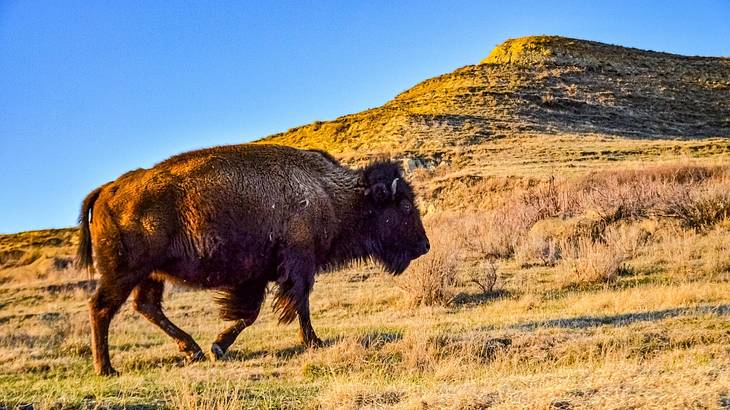
There is a lot of wildlife in North Dakota
Some of the most common wildlife in the state include buffalo, deer, antelope, eagles, and wild horses. No matter where you are in the state, you are bound to see some of this wildlife roaming around.
North Dakota contains a lot of lignite
One of the less well-known North Dakota facts about the state is that it contains a large amount of Lignite. Lignite is a type of coal, sometimes called brown coal, which was used by earlier settlers to heat their homes.
The first lignite mine in North Dakota opened in 1873, and 250 more lignite mines opened in the following 50 years. Today, around 30 million tons of Lignite are mined in the state annually.
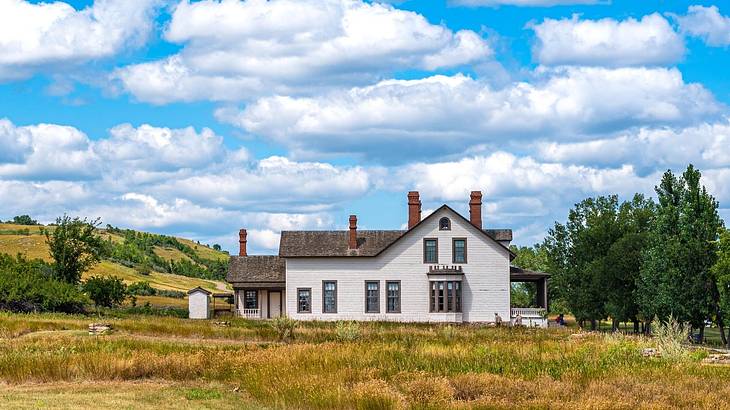
A re-creation of the Custer House is in North Dakota
The Custer House is in Fort Abraham Lincoln State Park, a famous North Dakota landmark. Today, the house is a historical museum where you can take a tour. It was the home of General Custer and his wife, Libbie.
The Nonpartisan League political party started in North Dakota
The Nonpartisan League was a political party that started in 1915 and focused on many radical issues. Their primary goals were improving state services, getting full suffrage for women, and getting state-owned banks and mills. The party took over the state government, which was previously Republican, in 1916 and remained in power until 1921.
Interesting Facts About North Dakota
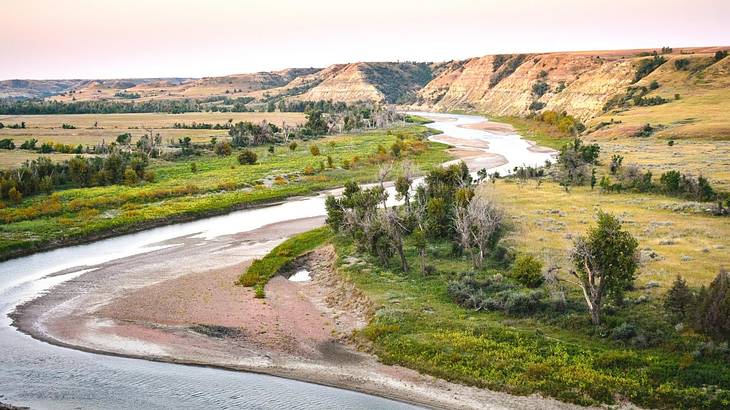
Next up are some interesting facts on North Dakota.
North Dakota has the least amount of forest land of any state
Today, only 1% of the state's land is forest, around 450,000 acres. This forestland is less than the state was ever known to have, which was only 1.5% or 700,000 acres.
The majority of the forest in North Dakota is in the Kildeer and Turtle Mountains, the Pembina Hills, and also near Devils Lake. These areas make up around 55% of all forest land, and the rest are near streams or the badlands.
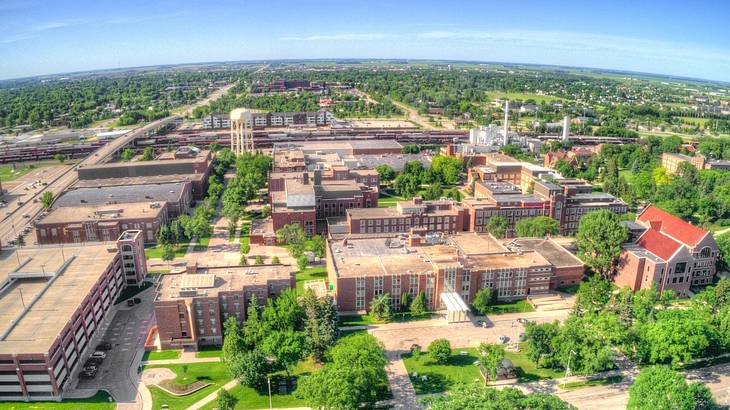
Grand Forks is the third-largest city in North Dakota
Grand Forks is on the eastern side of the state north of Fargo. The city has a population of 55,000. It is home to some of the state's major sites, like the University of North Dakota and the GF Air Force Base.
There are 14 North Dakota state parks
The parks are spread throughout the state. At the parks, you can camp with multiple options like tents, cabins, and yurts. There are also a lot of activities, including hiking, biking, cross-country skiing, and snowshoeing.
The North Dakota state tree is the American Elm
It is a common tree found in most parts of the state. It is for this reason that it was chosen as the state tree in 1947. There used to be many more of these trees, but a lot have been destroyed by the Dutch elm disease, which the elm bark beetle spreads.
The North Dakota state flower is the Wild Prairie Rose
It was adopted as the official state flower in 1907. The flower is easy to recognize as it has five bright pink petals, and they have yellow centers. The flower is found throughout the state, usually along roads and in pastures.
The North Dakota state bird is the Western Meadowlark
It was made the official state bird in 1947. The bird is brown with a yellow breast and a black bib. It is also the official state bird of five other states. These five states are Kansas, Montana, Nebraska, Oregon, and Wyoming.
The North Dakota State flag was first used in the Spanish-American War
The flag was designed in 1898. The name of the state was added to it in 1911. There is a bald eagle with an olive branch on the flag to signify peace. There are also the Latin words "E Pluribus Unum '' which means many uniting as one like all the states did.
The North Dakota State motto started as the motto of the Dakota Territory
The motto is "Liberty and Union Now and Forever, One and Inseparable". The motto is official as it is in the state's constitution. It was chosen to represent the country that stands as one.
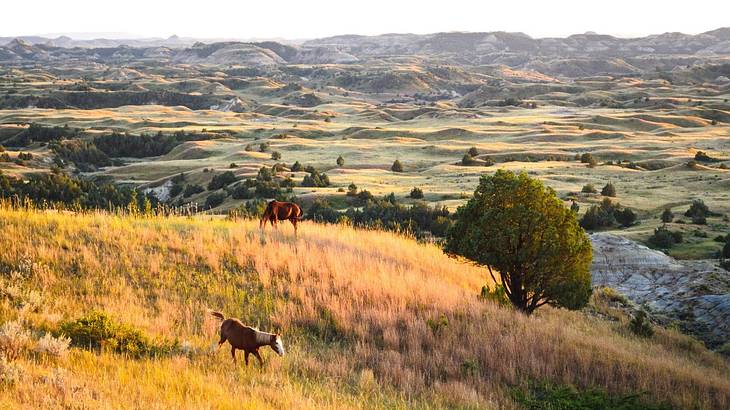
Theodore Roosevelt National Park is in North Dakota
The park was named after the former president since he loved the state and would often visit to hunt. The park is more than 70,000 acres large, and it is the only national park named for one person. The park is popular for spotting wildlife, hiking, camping, and horseback riding.
The San Haven Sanatorium used to be in North Dakota
It opened in 1909 as the North Dakota Tuberculosis Sanitarium as a way to help people with tuberculosis. The name changed to the San Haven State Hospital in 1971 and ended up closing in 1987.
Weird Facts About North Dakota
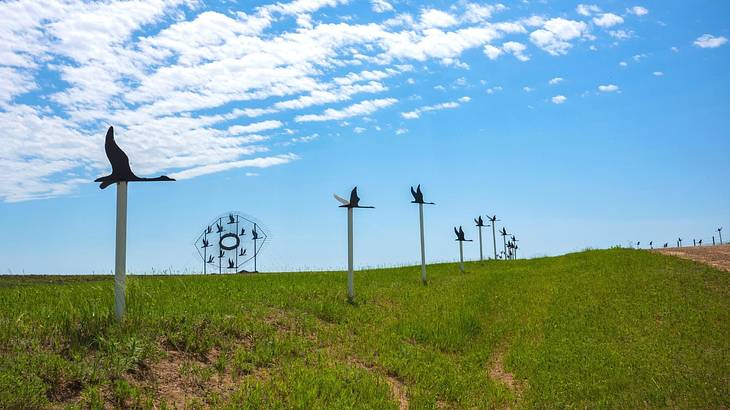
Below, you will learn some weird North Dakota facts.
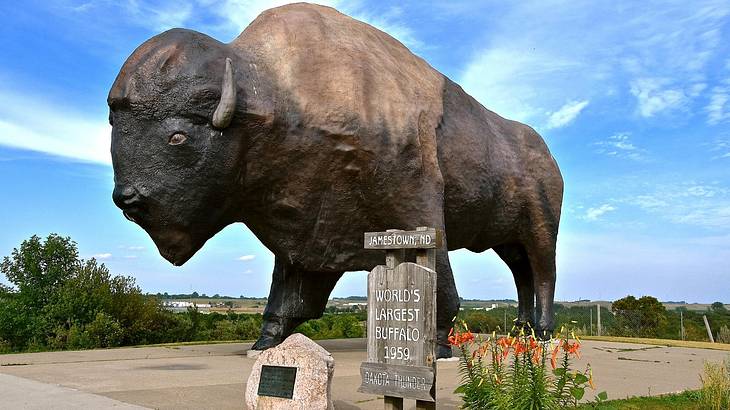
The world's largest buffalo monument is in North Dakota
It is in Jamestown, North Dakota, and it is 26 feet tall. It weighs 60 tons and it was designed and constructed in 1959 by a sculptor named Elmer Peterson. The buffalo statue was named Dakota Thunder in 2010 after more than 50 years of existence.
There is no official North Dakota state animal
However, they do have official types of specific animals. There is an official bird, a bug, a fish, and a horse. The Nokota horse is the closest thing they have to an official animal, and it was designated in 1993.
Milk is the official drink of North Dakota
Milk was named the official drink in 1983. It was chosen since milk and dairy are a big part of the state's agriculture. There are millions of pounds of milk produced in North Dakota every year.
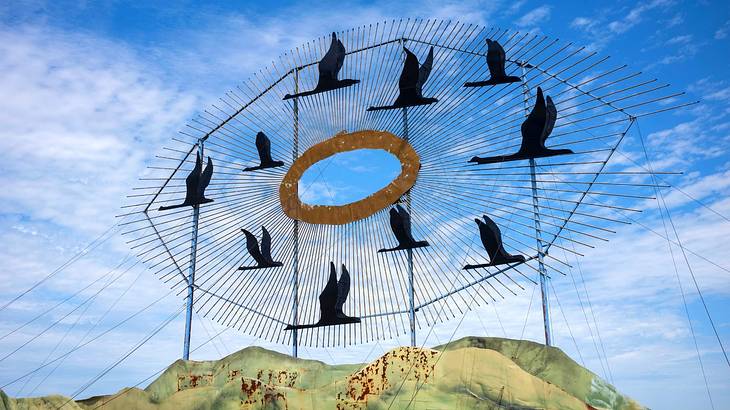
The largest metal sculpture in the world is in North Dakota
The statue is one of the seven that run along the Enchanted Highway. The largest is called the "Geese in Flight". It is in the Guinness World Records Book as the Largest Scrap Metal Sculpture. The sculpture was built in 2001. It is 110 feet tall and 150 feet wide.
The official dance of North Dakota is the Square Dance
The dance was chosen and approved to represent the state by the Legislative Assembly in 1995. The dance is popular at bars and dance halls throughout the state, especially in the past.
Cool Facts About North Dakota
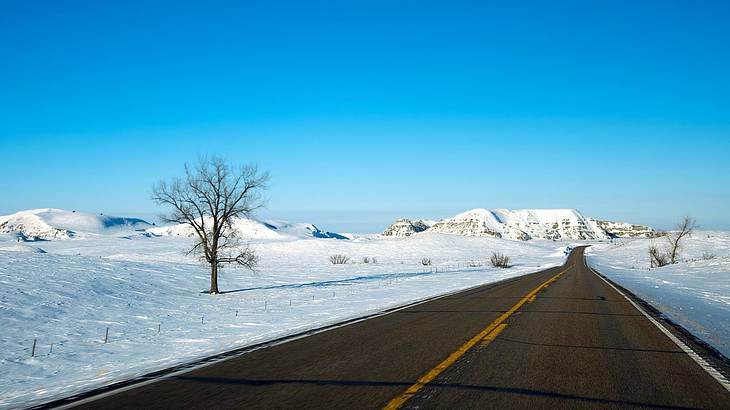
There are also some cool North Dakota facts to learn.
The geographical center of North America is in North Dakota
However, there is a debate over which city is the exact center. The town of Rugby, ND, claimed the title in 1928 when a mathematician determined the center to be near the city.
However, the appropriately named Center, North Dakota, was recently determined to be the more accurate center. A bar in the town now owns the trademark for the "Geographical Center of North Dakota".
8,962 people made snow angels in Bismarck
North Dakota holds the Guinness World Record for most snow angels, and it occurred on February 17th, 2007. It was an organized event by the State Historical Society of North Dakota.
The largest pancake feed in the world was in North Dakota
It took place on February 9th, 2008, in Fargo, North Dakota. During the 50th annual Pancake Karnivale, put on by the Fargo Kiwanis Club, there were 34,818 pancakes served.
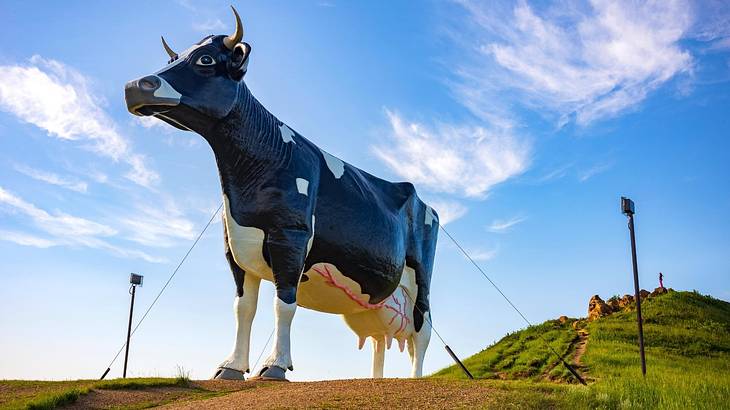
The largest Holstein is in New Salem, North Dakota
The cow is named Salem Sue, and she was built in 1974. She weighs six tons and is 50 feet long and 38 feet tall. Sue lives on the top of a hill and is technically made of three parts since that was the only way to get her up the hill.
North Dakota produces more honey than any other state
Every year, more than 38.6 million pounds of honey is produced by the honey bees in North Dakota. The honey is valued at more than 61 million dollars, more than any other state. All the honeybees in the state are tracked, as their owners need to have a license.
Scary Facts About North Dakota
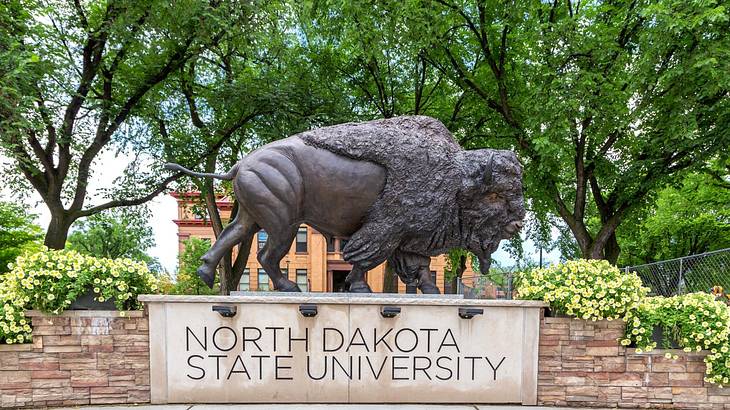
Get ready; there are also some scary North Dakota facts and information to know!
There are ghosts at North Dakota State University
There have been reports of ghosts in multiple places on campus. Ceres Hall and Minard Hall have sounds people hear that cannot be explained.
These two halls are likely haunted as two people have died in each one. A resident of Thompson Hall reported seeing a ghost in her closet, among other ghost stories.
Riverside Cemetery is one of the haunted places in North Dakota
People who have visited the cemeteries have heard knocking noises, which have been recorded. The graveyard is the oldest and largest in Fargo, and it opened in 1879.
With over 18,000 people buried here, there is bound to be some paranormal activity. Other than the sounds, photos have been taken there with orbs and mists.
Harvey Library, a small public library in North Dakota, is haunted
People in the library have experienced things like flickering lights, glitches with computers, and missing objects which are believed to be from paranormal spirits.
The ghost is said to be Sophie Eberlein-Bentz, who used to live where the library is today. She was murdered by her husband when he killed her with a hammer.
There are 43 abandoned towns in North Dakota
These towns are throughout the state. They are considered ghost towns since they have very few people and buildings left, if any. These towns used to be populated, but they failed economically, and people left them until they were abandoned.
North Dakota has extreme weather and temperatures
The lowest temperature ever recorded in North Dakota was negative 60 degrees Fahrenheit. The temperature was recorded on February 15th, 1936, in Parshall, ND. Later that year, the highest temperature recorded to date was 121 degrees Fahrenheit in Steele, ND.
These are the maximum temperatures recorded in North Dakota, but other parts of ND have also reached temperatures over 100 degrees and below negative 40 degrees
Historical Facts About North Dakota
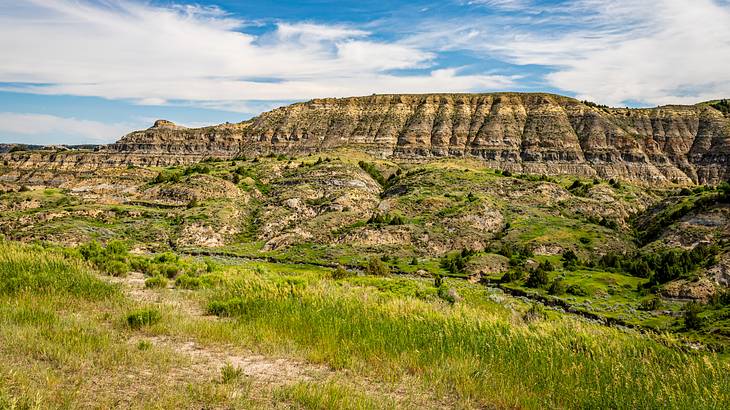
Next, you will find some North Dakota history facts.
North Dakota was part of the Louisiana Purchase
All the land that makes up North Dakota was part of the 530 million acres that the United States bought. The land cost $15 million, and it was purchased from France in 1803. Thomas Jefferson approved the purchase to help the United States expand to the West.
The state started as the Dakota Territory
What is now South Dakota was also part of the territory. It was made into a territory on March 2nd, 1861. The original territory also included parts of Montana and Wyoming. Over time, the boundaries changed to fit just North and South Dakota. Then Wyoming was added back, then removed again.
North Dakota became the 39th state in 1889
North Dakota became a state on November 2nd, 1889. It was separated from the other half of the Dakota Territory, which became South Dakota on the same day. John Miller was the state's first governor, and it was a Republican state.
President Benjamin Harrison made North Dakota an official state
He signed the papers on November 2nd, 1889, the same day South Dakota became a state. Both states wanted to be admitted to the United States first, but Harrison did not want to choose which one would be first.
So he shuffled the papers and signed them right after each other, so no one knew which one officially became a state first. North Dakota is considered first since it comes first alphabetically.
Over thirty-five thousand men from North Dakota fought in World War I
There were exactly 35,448 men from the state that served in the Armed Forces during the 19 months plus that the United States was fighting in the war. This number does not include the women who served as nurses or performed other duties to assist in the war too.
Important Facts About North Dakota
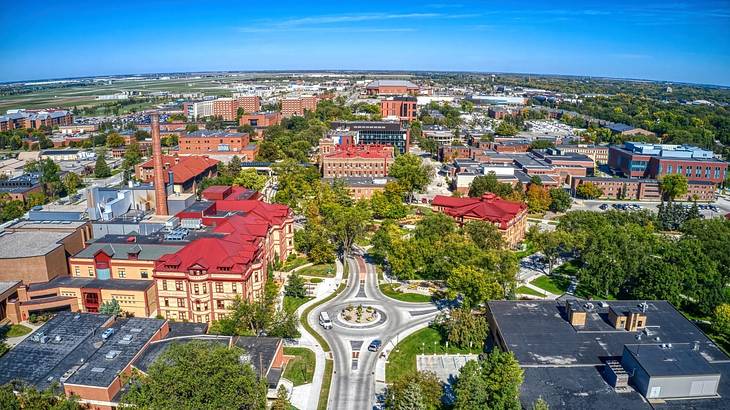
Finally, there is some important information about North Dakota to know.
The North Dakota state capital is Bismarck
The city has a population of over 133,000 people, which includes the metropolitan area. This makes it the second-largest city in the state.
There are over 4,600 government workers who work in the city, mainly at the state capitol building. The town was founded in 1872 and is named after the German diplomat Otto von Bismarck.
The population of North Dakota is over 775,000 people
This was the population of the state in 2021, and it increased by 15,000 people in 2022. It is the fourth least-populated state, with only Alaska, Vermont, and Wyoming having a smaller population.
Fargo is the largest city by population in North Dakota
Fargo is on the eastern border of North Dakota, with Minnesota just across the Red River from the city. Around 125,000 people live in the town, with another 113,000 living in the metropolitan area. The city is in Cass County.
Many Native American tribes live in North Dakota
They lived throughout the state, and today there are more than 31,000 Native Americans residing in North Dakota. The state recognizes multiple tribes in the state, including the Spirit Lake Nation, the Sisseton-Wahpeton Oyate Nation, and the Turtle Mountain Band of Chippewa Indians. There is also the Standing Rock Sioux Tribe.
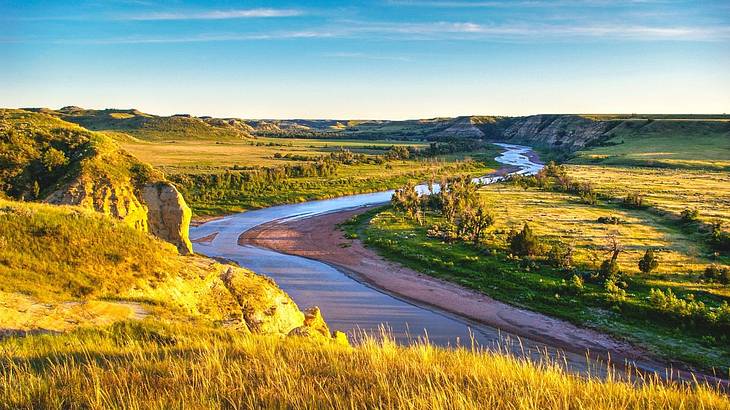
The Missouri River runs through North Dakota
It goes from the southeastern part of the state to the northwest. North Dakota has a lot of efforts and programs in place to keep the water safe and the river flowing. The river makes up the most readily available water source in the state.
Conclusion
North Dakota is one of the least-visited states in the whole country, but that does not mean it does not have cool places to visit and things to see!
You will find the Enchanted Highway and the world's largest buffalo monument in the state. There are also haunted places, many state parks, and the Theodore Roosevelt National Park to explore, and so much more.
Want to keep exploring?
Subscribe for discounts on tickets and hotels and our latest guides.
Thank you for subscribing
We will be in touch soon with discounts on tickets and hotels and our latest guides.
Want to keep exploring?
Subscribe for discounts on tickets and hotels and our latest guides.
Thank you for subscribing
We will be in touch soon with discounts on tickets and hotels and our latest guides.

